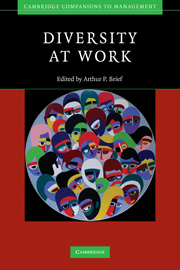Book contents
- Frontmatter
- Contents
- List of figures
- List of tables
- List of contributors
- Foreword
- Preface
- 1 Introduction: Where the sweet spot is: Studying diversity in organizations
- Part I Conceptual foundations
- Part II Emerging theoretical approaches
- 4 Identity negotiation processes amidst diversity
- 5 Diversity, conflict, and their consequences
- 6 Shifting frames in team-diversity research: From difference to relationships
- 7 Putting your own down: How members of disadvantaged groups unwittingly perpetuate or exacerbate their disadvantage
- Part III Moving ahead: Agendas for practice and research
- Index
- References
7 - Putting your own down: How members of disadvantaged groups unwittingly perpetuate or exacerbate their disadvantage
Published online by Cambridge University Press: 19 May 2010
- Frontmatter
- Contents
- List of figures
- List of tables
- List of contributors
- Foreword
- Preface
- 1 Introduction: Where the sweet spot is: Studying diversity in organizations
- Part I Conceptual foundations
- Part II Emerging theoretical approaches
- 4 Identity negotiation processes amidst diversity
- 5 Diversity, conflict, and their consequences
- 6 Shifting frames in team-diversity research: From difference to relationships
- 7 Putting your own down: How members of disadvantaged groups unwittingly perpetuate or exacerbate their disadvantage
- Part III Moving ahead: Agendas for practice and research
- Index
- References
Summary
Group-based disadvantage in organizations
One of the great challenges contemporary work organizations face, is the increasing diversity of the labor force. It is generally acknowledged that, in addition to a variety of practical issues that may play a role, there are a number of relevant psychological processes that affect the well-being, motivation, and career performance of workers with different ethnic or demographic backgrounds. For instance, in relation to personnel selection, it has been established that the same job application is rated differently, depending on whether or not the person who submitted it uses an ethnic name (Bovenkerk, Gras, and Ramsoedh, 1995; see also Riach and Rich, 2002). Likewise, the same product is evaluated less favorably when people think it is made by a female worker than when they think it is produced by a male (e.g., Bartol, 1999; Davison and Burke, 2000; Graves, 1999). When the quality of a particular work performance is established objectively, people still draw different conclusions about the actual competence of the person, or hold different expectations about future possibilities, depending on their ethnic or gender identity (Deaux, 1976; 1984; Deaux and Emswiller, 1974; Swim et al., 1989). As a result of such psychological biases, individual workers may experience discrimination in employment situations, on the basis of their age (Bendick, Jackson, and Romero, 1996), race and gender (Hitt, Zikmund, and Pickens, 1982; McIntrye, Moberg, and Posner, 1980), physical disabilities (Ravaud, Madiot, and Ville, 1992), or sexual orientation (Weichselbaumer, 2003).
- Type
- Chapter
- Information
- Diversity at Work , pp. 202 - 262Publisher: Cambridge University PressPrint publication year: 2008
References
- 14
- Cited by



